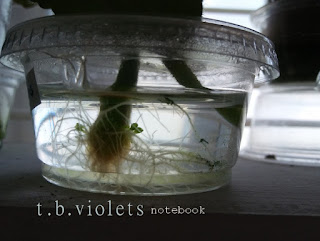Growing Tips
MUST HAVES for violet growing. These are just my tips that I've learned from my own success in growing and propagating violets and in no way should be taken as the only way of successfully growing violets. Every one has their own way of doing things and making things work for them. These are things I learned that helped me successfully grow my collection as a violet hobbyist and enthusiast that might help someone else along the way.
SOIL - African violets thrive in a light soil that allows the roots to get air. Perlite, vermiculite, charcoal and coconut coir all provide aeration for delicate roots to develop. Whether you bottom water or use wicks and reservoirs, you can easily make your own soil. Often store bought and labeled soil for african violets is too dense and heavy and is not good for violets.
LIGHTING - The right lighting produces profuse blooming. Some violets need more light, some need less. Most will benefit from some supplemental lighting. Most violets do well in a bright window with no direct sun. Many growers use a combination of natural light, fluorescent, LEDs, grow lights and full spectrum lighting for their violets.
WATER - Always water with room temperature water never use cold water, tap water or distilled water. Charcoal, mineral or ion filtered water (not salt), rain water or spring water is best. I mix my filtered water up in a gallon jug with plant food and let it sit overnight before I water. Any chlorine in the water is released as it reaches room temperature. Also, if your city uses chloramine to treat the water, you need to use a chloramine buster. Chloramine will turn violet leaves brown. If you notice salt buildup on the surface of the soil, you can water from the top to flush the salts out of the soil - some growers replace the top soil with fresh violet mix or repot.
AIR - Give your violets air circulation. They have to breathe to stay alive. A small fan on low will circulate air around them without blowing air on them directly and keep them from getting PM, powdery mildew.
PEST PREVENTION - A good fungicide/pest control spray. When in doubt - spray and isolate. There is a fungus now that can wipe out your whole collection if it gets into your violets. It's devastating so if you suspect something is wrong with a plant, be aggressive with the spray and isolate immediately. Learn more about Western Flower Thrips and INSV.
GROOMING - Pick off faded and dying flowers, buds and leaves as soon as you notice them. Brush dirty leaves with a soft paint brush to clean them. An occasional tepid water bath is good for them and cleans off the leaves. Always make sure to remove water from the stem.
HUMIDITY - You must provide and control moisture. Too much and they will mold or rot. Too little and they will dry up. Humidity trays are helpful as are humidifiers in the winter where there is dry heat.
DOMING - Domes add humidity to promote root growth. Plantlets and cuttings that do not yet have roots need to be enclosed in some type of plastic dome or bag if they are inserted into soil. Some people provide an air hole for some moisture to escape and some seal the plastic closed after blowing air in it. After plants have developed roots and grown large enough to move out in the open on a humidity tray, you can gradually remove the dome.
It's really that simple to grow beautiful African Violets! The biggest thing they require is attention. You have to check on them nearly every day and if you do take care of them, you'll be rewarded with healthy, beautiful, abundant plants and blooms year round.
Happy Violeting!!!


